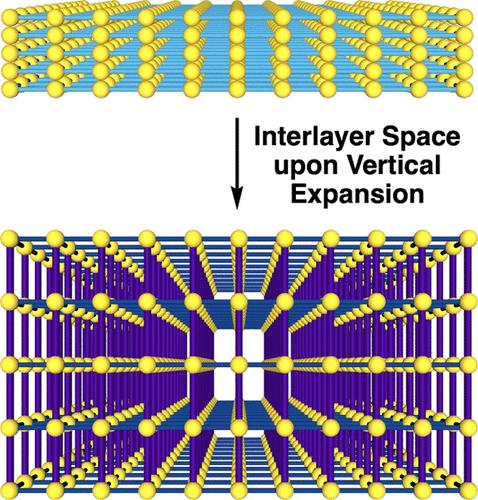当前位置:
X-MOL 学术
›
J. Am. Chem. Soc.
›
论文详情
Our official English website, www.x-mol.net, welcomes your
feedback! (Note: you will need to create a separate account there.)
Vertically Expanded Crystalline Porous Covalent Organic Frameworks
Journal of the American Chemical Society ( IF 14.4 ) Pub Date : 2024-11-15 , DOI: 10.1021/jacs.4c11880 Shuailei Xie, Matthew A. Addicoat, Donglin Jiang
Journal of the American Chemical Society ( IF 14.4 ) Pub Date : 2024-11-15 , DOI: 10.1021/jacs.4c11880 Shuailei Xie, Matthew A. Addicoat, Donglin Jiang

|
Covalent organic frameworks (COFs) can be developed for molecular confinement and separation. However, their proximate π stacks limit the interlayer distance to be only 3–6 Å, which is too small for guests to enter. As a result, COFs block access to the x–y space and limit guest entry/exit strictly to only the pores along the z direction. Therefore, the extended faces of each layer are hidden between layers, precluding any interactions with guest molecules. Here, we report a strategy for opening interlayer spaces of COFs to attain newly accessible nanospaces between layers. This becomes possible using coordination bonds to replace the conventional π–π stacks between layers. We demonstrate this concept by synthesizing two-dimensional covalent cobalt(II) porphyrin layers through topology-guided polymerization, which were piled up by bidentate axial pillars through coordination bonds with cobalt(II) porphyrin along the z direction, assembling vertically expanded COFs via a one-pot reaction. The resultant frameworks separate the layers with axial pillars and create discrete apertures between layers defined by the molecular length of the pillars. Consequently, the originally inaccessible interlayers are open for guest access, while the polygonal π planes are exposed to trigger various supramolecular interactions. Vapor sorption, breakthrough experiments, and computational studies mutually revealed that the vertically expanded frameworks with optimal interlayer slits induce additional interactions to discriminate benzene and cyclohexane and separate their mixtures efficiently under ambient conditions.
中文翻译:

垂直膨胀结晶多孔共价有机框架
共价有机框架 (COF) 可用于分子限制和分离。然而,它们的邻近π堆栈将层间距离限制为仅 3-6 Å,这对于客人来说太小了。因此,COF 会阻止对 x-y 空间的访问,并将客户机的进出严格限制在沿 z 方向的孔隙中。因此,每一层的延伸面都隐藏在层之间,排除了与客体分子的任何相互作用。在这里,我们报告了一种打开 COF 层间空间以获得层间新可访问的纳米空间的策略。使用配位键取代层间传统的 π-π 堆栈成为可能。我们通过拓扑引导聚合合成二维共价钴 (II) 卟啉层来证明这一概念,这些层通过与钴 (II) 卟啉的配位键沿 z 方向由双齿轴柱堆积,通过一锅反应组装垂直膨胀的 COFs。所得框架用轴向柱分隔各层,并在由柱的分子长度定义的层之间创建离散的孔。因此,原本无法接近的夹层对访客开放,而多边形π平面则暴露在外,触发各种超分子相互作用。蒸汽吸附、突破性实验和计算研究共同表明,具有最佳层间狭缝的垂直膨胀框架会诱导额外的相互作用,以区分苯和环己烷,并在环境条件下有效地分离它们的混合物。
更新日期:2024-11-15
中文翻译:

垂直膨胀结晶多孔共价有机框架
共价有机框架 (COF) 可用于分子限制和分离。然而,它们的邻近π堆栈将层间距离限制为仅 3-6 Å,这对于客人来说太小了。因此,COF 会阻止对 x-y 空间的访问,并将客户机的进出严格限制在沿 z 方向的孔隙中。因此,每一层的延伸面都隐藏在层之间,排除了与客体分子的任何相互作用。在这里,我们报告了一种打开 COF 层间空间以获得层间新可访问的纳米空间的策略。使用配位键取代层间传统的 π-π 堆栈成为可能。我们通过拓扑引导聚合合成二维共价钴 (II) 卟啉层来证明这一概念,这些层通过与钴 (II) 卟啉的配位键沿 z 方向由双齿轴柱堆积,通过一锅反应组装垂直膨胀的 COFs。所得框架用轴向柱分隔各层,并在由柱的分子长度定义的层之间创建离散的孔。因此,原本无法接近的夹层对访客开放,而多边形π平面则暴露在外,触发各种超分子相互作用。蒸汽吸附、突破性实验和计算研究共同表明,具有最佳层间狭缝的垂直膨胀框架会诱导额外的相互作用,以区分苯和环己烷,并在环境条件下有效地分离它们的混合物。


















































 京公网安备 11010802027423号
京公网安备 11010802027423号